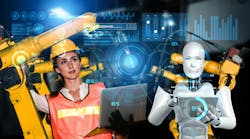While the answer to this question is generally yes, there are drawbacks.
First, let’s look at some recent research from the National Safety Council. In a white paper, Improving Workplace Safety with Robots, the association looked at how robots can reduce the risk of serious injuries and fatalities (SIFs). To do this they looked at "automated facility inspections, confined space entry, moving parts and equipment, machine tending, pick and-place, hazardous materials handling, and precision welding and cutting.”
The report reached five key findings:
1. Robots are available in various control configurations – remote-controlled, pre-programmed or autonomous – as well as in various forms – autonomous mobile robots (AMRs), automated guided vehicles (AGVs), articulated robots, humanoid robots and collaborative robots (cobots).
2. AGVs and AMRs are available as off-the-shelf solutions for small and large industrial warehousing and factory facilities, requiring approximately one week of mapping and route planning before robotics pallets and mobile shelving units become operational.
3. Remote-controlled robots offer high-value use cases for confined entry inspections, working from height and hazardous material handling, reducing the risk of human exposure to toxic gases, high temperatures, electric shock hazards and falls from height.
4. Cobots and robotic arms are well established for repetitive manual tasks, such as machine tending, parts repositioning and pick-and-place – and implementation and return-on-investment (ROI) can be seen quickly enough for organizations of all sizes. Such deployments can reduce the risk of musculoskeletal disorders from repetitive manual work and allow workers to focus on more varied, complex tasks.
5. Deployment of safety-related robotics in more complex and dynamic environments, such as construction, mining and logging require longer development and testing times with the need for advanced computer vision and artificial intelligence technologies – resulting in such use cases being currently available only to large industrial operations.
6. Pre-built, easy-to-use robotics hardware and software packages are being continuously developed for additional common safety-related use cases – meaning the real ROI concerning safety will be seen in the near future for both large and small industrial organizations.
To review the entire analysis of the report, click here.
Another study from the Brookings Institution, Keeping Workers Safe in the Automation Revolution, agreed for the most part but also pointed out some warnings.
Here is an excerpt from that report:
Automated systems can offer considerable safety benefits to human workers, as robots can help prevent injuries and adverse health effects resulting from working in hazardous conditions (Trevelyan et al., 2016). These include musculoskeletal disorders caused by repetitive or awkward movements or traumatic injuries. Robots also have the potential to mitigate numerous hazards in emergency response scenarios, such as chemical spills (Ishida et al 2006). Additionally, robots can minimize risks arising from human error. When a task is repetitive and monotonous, humans are prone to make mistakes, while robots can consistently perform these tasks without errors.
However, robots can also introduce various hazards for workers (Kirschgens et al. 2021). For instance, industrial robots that are designed to operate at a distance from workers often lack the necessary sensory capabilities to detect nearby humans, creating a potential risk. Furthermore, the proliferation of collaborative robots, intended to directly interact and share workspaces with humans, can pose additional safety risks (Matthias et al 2011). In the short run, the lack of experience with robots may therefore temporarily increase risks. Surveys show some evidence that workers often feel unsafe working around robots (McClure, 2018, Yam et al. 2023).
In fact, a recent analysis from the OSHA showed that Amazon’s serious injury rates are much higher than those observed by other companies and that injury rates were especially high at facilities with robots. An estimate from the Center for Investigating Reporting based on 150 warehouses analyzed over 4 year suggests that warehouses with robots experience 50% more injuries (Evans 2020). Yet, this analysis is mostly descriptive and may also reflect the fact that in facilities where the risks are higher there may be more incentives to adopt robots to eventually reduce injury rates.
